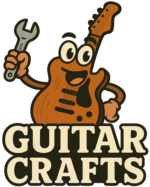Customizing a guitar isn’t just about pickups and finishes — it’s also about the finer details, like inlays. In this guide on how to create custom inlays for your guitar fretboard, we’ll walk you through the aesthetic, technical, and creative aspects of inlay design, from materials to installation. Whether you’re building from a kit or revamping your old axe, fretboard inlays are your chance to make a personal statement.
Introduction to the Art of Custom Guitar Fretboard Inlays
Why Custom Fretboard Inlays Matter to Guitarists
Fretboard inlays aren’t just decorative dots to mark positions — they’re a canvas for creativity. For many guitarists, custom inlays become a signature, a visual representation of their personality, story, or brand. These details set your instrument apart, especially if you’re working from a kit where personalization is part of the process.
Enhancing Aesthetics and Personal Expression Through Inlays
From intricate vines to minimalist geometric patterns, inlays can enhance the visual appeal of your guitar dramatically. Whether you’re going for a vintage vibe or a futuristic aesthetic, the right inlay pattern adds character and presence.
A Brief Look at the History and Cultural Significance
Historically, ornate inlays were used on classical and flamenco guitars to showcase craftsmanship. In blues and rock, pearl and abalone inlays became synonymous with custom shop builds. Today, inlays can represent anything — family symbols, cultural motifs, or abstract art — turning the fretboard into a personal canvas.
** Here’s a little transparency: Our website contains affiliate links. This means if you click and make a purchase, we may receive a small commission. Don’t worry, there’s no extra cost to you. It’s a simple way you can support our mission to bring you quality content. **
As an Amazon Associate, I earn from qualifying purchases.
Understanding Custom Fret Inlays: What You Need to Know
Can You Get Custom Fret Inlays?
Absolutely. You can design your own, order pre-made inlay sets or collaborate with a luthier. If you’re building from a kit, many sellers allow you to select or upgrade to custom inlays. You can also retrofit an existing guitar with new inlays, although it’s more involved.
For those just getting started with electric kits, check out our Step-by-Step Guide To Building Your First Electric Guitar Kit to understand how inlays fit into the broader build process.
Materials Commonly Used for Custom Inlays
- Mother of Pearl – Classic, shimmering, and elegant.
- Abalone – Iridescent and colorful with lots of visual depth.
- Wood – Subtle and organic, great for minimalist or natural designs.
- Metal – Adds a sleek, modern touch.
- Plastic/Resin – Affordable and flexible for color and pattern work.
Each material has different carving and finishing needs, so consider your tools and skill level when choosing.
Design Considerations: Patterns That Resonate
When designing inlays:
- Think about scale length and fret spacing — some patterns won’t work on smaller necks.
- Choose themes that tell a story: celestial bodies, tribal motifs, initials, or animals.
- Keep it cohesive. If your guitar has a specific color or tone wood, coordinate your inlay color and style accordingly.
Step-by-Step Guide: Adding Inlays to a Fretboard
Preparing Your Guitar: Tools and Materials Needed
Here’s what you’ll need:
- Template or sketch of your inlay design
- Inlay material (pearl, abalone, wood, etc.)
- Dremel or precision router
- Fretboard (ideally before frets are installed)
- Epoxy or CA glue
- Razor blade/sandpaper
- Protective mask and goggles
Don’t forget, before doing detailed fretboard work, make sure you’ve already addressed the truss rod adjustment and neck relief for accurate inlay depth.
Adding the Inlays: Step-by-Step Process
- Sketch and Plan – Map your design on paper or use software like Inkscape or Adobe Illustrator.
- Mark the Fretboard – Lightly trace your inlay design onto the fretboard using a pencil or stencil.
- Rout the Cavities – Use a Dremel with a precision base to route each cavity, carefully staying within the traced lines.
- Fit the Inlays – Shape your inlay material to match the cavity using files and sandpaper.
- Glue It In – Use CA glue or epoxy to secure the inlay into place.
- Level and Sand – After the glue cures, use a razor blade to shave excess, then fine-grit sandpaper to make the surface flush.
- Finish the Fretboard – Apply fretboard oil or lacquer (depending on your wood type) for protection.
Want more hands-on guitar building tips? Explore our article on Essential Tools Every Electric Guitar Kit Builder Should Have.
Mastering the Craft: How Inlays Are Made
Overview of the Inlay Creation Process
At the professional level, inlays are CNC-cut or hand-carved with extreme precision, then fitted into pre-milled fretboards. DIY methods often involve manual cutting and filing with jeweler’s saws and fine abrasives.
Techniques: Pro Luthiers vs. DIY
Professionals:
- Use laser cutters or CNC machines.
- Work with custom-designed software.
- Often use binding and purfling for intricate designs.
DIY Builders:
- Rely on patience, templates, and hand tools.
- Can achieve incredible results with basic equipment and a steady hand.
Common Challenges and Fixes
- Cavity too deep or wide: Fill with tinted epoxy and retry.
- Cracked inlays: Work slowly, especially with brittle materials like pearl.
- Uneven surface: Sand gradually with flat blocks.
Evolving Your Instrument: Changing Fretboard Inlays
Can You Change Fretboard Inlays?
Yes — but it’s tricky. If your guitar has dot or block inlays, you can carefully route them out and replace them. For more complex patterns or binding work, a pro may be your best bet.
Not sure if this is the right time for a swap? Revisit our guide on Customizing Your Electric Guitar Kit With Unique Fretboard Inlays.
Assessing Risks and Benefits
Risks:
- Damaging the fretboard
- Weakening fret slots
- Uneven finish or mismatched filler
Benefits:
- Improved aesthetics
- Personal connection to the instrument
- Potential resale value boost (for custom or artistic guitars)
Tips for Working With Professionals
- Bring sketches or reference photos to your consultation.
- Choose luthiers with proven inlay portfolios.
- Set clear expectations about turnaround time and cost.
Final Thought…
Creating custom fretboard inlays is one of the most satisfying ways to personalize your guitar. Whether you’re building from scratch or upgrading your favorite axe, these tiny artworks can tell your musical story every time you play. With the right tools, materials, and creativity, your fretboard becomes more than a guide…
It becomes a masterpiece!
There are 100’s of ways you can build a business around your passion for guitar building.
Check it out…




This guide is beautifully thorough—custom inlays really do elevate a guitar from a finished product to a personal statement. I love how you balance the artistic side—choosing motifs that speak to personality or story—with the hands-on technique of routing, fitting, and finishing. Emphasizing the right tools, from Dremels to templates, and the importance of precise planning before carving gives a real sense of confidence for anyone considering this project.
I also appreciate how you address the history of inlays—how they began as craftsmanship markers and have become deeply personal, artistic touches on modern builds. Highlighting risks like routing cavities too deep or uneven sanding makes the guide feel both creative and grounded.
One detail that stood out: your tips for managing brittle materials like pearl or abalone with extra patience and restraint. That wisdom alone can make all the difference between a smooth install and a cracked moment!
Thank you so much! I’m thrilled to hear the guide resonated with you. Custom inlays are one of those details that let builders really leave their personal mark on a guitar, and it’s great to know the balance of artistry and technique came through.
I’m especially glad the tips on brittle materials like pearl and abalone stood out. A little patience really does go a long way, and avoiding that “cracked moment” is always satisfying! It’s rewarding to share techniques that help builders feel confident tackling something that might seem intimidating at first.
Hearing that the historical context and practical advice were useful makes putting these guides together all the more worthwhile. I hope it inspires many builders to create inlays that are both beautiful and personal!
Thanks again,
~Wayne
This is one of the clearest guides I’ve read on this topic. Divorce can bring so much confusion, but you show practical steps to ease the stress for children. I think naming emotions and letting kids know their feelings are normal is very powerful. Many parents skip that part. I also love your reminder about routines because children rely on stability.
Thank you for your thoughtful comment! It seems like this might have been intended for a different page, but I really appreciate you taking the time to share your insights. Your points about acknowledging emotions and maintaining routines are excellent advice for any parent navigating a challenging situation.
~Wayne